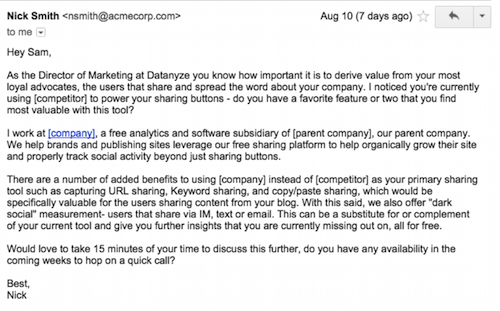Every cold email needs a hook. Something that forces prospects to lean in and forget that they are actually being sold to. Finding the appropriate hook for each prospect is insanely time-consuming, but if done right, can mean the difference between a “yes” and crickets.
Traditionally, hooks are found by scanning a prospect’s LinkedIn or Twitter profile, doing a quick Google search, looking for mutual connections or absorbing the marketing spew on a prospect’s website. This process isn’t very scalable, and prospects are getting tired of feeling obliged to take a meeting simply because you both grew up in the same part of town or worked for the same company a few years back.
Below, I outline five new ways salespeople are uncovering valuable information from their prospect’s software stack to derive intelligent, scalable hooks that instantly catch the eye of their targets. To get started uncovering the software stack of any website, you’ll need to install this free Chrome extension.
Method 1: Know which prospects are using a competitor’s software
First and foremost, it’s extremely helpful to know which companies are using your competitor’s software. Barring any severe pricing differences or locational constraints, these prospects are almost always going to be a great fit for your product. But how do you create a compelling hook for them to take a meeting without sounding pushy or arrogant?
When reaching out to your competitors’ customers, keep in mind that there is probably a relationship that is already in place. Understand that your email may be forwarded along to your competitor, so don’t say anything you can’t back up and always maintain a professional tone.
Here are some tips:
- Mention the product they are using and acknowledge that you offer an alternative.
- Focus on what makes your product unique and why customers have chosen it over alternative solutions. Never (ever ever ever) bash your competitor’s product.
- Stay away from vague value statements that cannot be backed up by hard stats.
- Cite information everyone can access (e.g. analyst reports, case studies, industry rankings, customer reviews)
- Ask if it makes sense to have an introductory conversation. Let them know that it can be purely educational.
Here’s a real cold email example that blew me away. I tried not to reply, but just couldn’t…

Method 2: Know which prospects are using software you integrate with
Unless you’re on the sales team at Salesforce, IBM, or another tech behemoth, chances are your developer team has built out an integration or two that make it easier for customers to adopt your product within their existing workflows. Highlighting your product in the context of these workflows conveys your expertise in the space and helps your prospect better visualize how they could use your tool from day one.
Here’s an example of an email I received that uses an upcoming integration as a hook. There was previous communication, so the note was pretty short and somewhat void of context. To make it stronger, I would add an additional line that discusses how the integration works and why companies are leveraging it.

Note that this technique doesn’t just work for integrations. If you sell consulting or implementation services around a particular platform (say Salesforce, Magento, or AdWords) it pays to know which companies are working with these software providers. The pitch is pretty much the same too :).
Method 3: Know which prospects are using enterprise vs SMB software
If you sell enterprise software, why waste time on prospects who don’t need all the bells and whistles? If you sell PPC optimization services and a prospect isn’t using Adwords, you’re probably just wasting your time.
Taking a quick look at your prospect’s tech stack can help you quickly determine whether or not it’s worth reaching out. Here’s a quick graphic that outlines some common enterprise vs SMB software. It’s by no means bulletproof, so feel free to create your own list.
Method 4: Know which prospects tend to build vs buy
Some companies have extremely robust developer teams. If this is the case, they may choose to build a lot of functionality in-house or customize their setup using popular open source platforms like Magento, Hadoop or WordPress.
If you notice that an Ecommerce website is not using a hosted Ecommerce platform or a popular blog is not using a hosted CMS, chances are they’ve built their own solutions and prefer customization over WYSIWYG (what you see is what you get). In this case, you’ll want to acknowledge the elephant in the room and highlight what customization options your software has to offer.
Method 5: Know which prospects are going to events
What better way to get your prospect’s attention than to invite them for drinks at an upcoming event? Let’s say next week is Marketo Summit (or Dreamforce or Opticon or Inbound), and you’re chatting up a marketer who happens to be on the fence about taking a meeting. Rather than wasting a bullet and asking them if they’re going, check their website to see if they use Marketo. If they do, you’re in luck!
As a second example, let’s say your company is sponsoring Dreamforce in a few weeks, but wasn’t granted access to the attendee list. In this case, you can create a report that reveals every company using Salesforce. This can be filtered by location, revenue, employee count and industry to make sure you don’t miss the mark.
This article was syndicated from Business 2 Community: 5 Ways You Can Use A Prospect’s Software Stack To Write Better Cold Emails
More Digital & Social articles from Business 2 Community:





